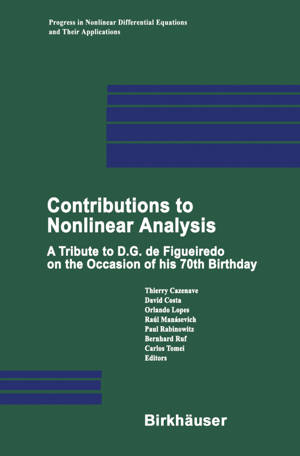
- Afhalen na 1 uur in een winkel met voorraad
- Gratis thuislevering in België vanaf € 30
- Ruim aanbod met 7 miljoen producten
- Afhalen na 1 uur in een winkel met voorraad
- Gratis thuislevering in België vanaf € 30
- Ruim aanbod met 7 miljoen producten
Zoeken
Contributions to Nonlinear Analysis
A Tribute to D.G. de Figueiredo on the Occasion of His 70th Birthday
€ 167,95
+ 335 punten
Omschrijving
This paper is concerned with the existence and uniform decay rates of solutions of the waveequation with a sourceterm and subject to nonlinear boundary damping ? ? u u =u u in ? ×(0, +?) ? tt ? ? ? ? u=0 on ? ×(0, +?) 0 (1. 1) ? ? u+g(u)=0 on ? ×(0, +?) ? t 1 ? ? ? ? 0 1 u(x,0) = u (x); u (x,0) = u (x), x? ?, t n where ? is a bounded domain of R, n? 1, with a smooth boundary ? = ? . 0 1 Here, ? and ? are closed and disjoint and ? represents the unit outward normal 0 1 to ?. Problems like (1. 1), more precisely, ? u u =?f (u)in? ×(0, +?) ? tt 0 ? ? ? ? u=0 on ? ×(0, +?) 0 (1. 2) ? ? u =?g(u )?f (u)on? ×(0, +?) ? t 1 1 ? ? ? ? 0 1 u(x,0) = u (x); u (x,0) = u (x), x? ?, t were widely studied in the literature, mainly when f =0, see[6,13,22]anda 1 long list of references therein. When f =0and f = 0 this kind of problem was 0 1 well studied by Lasiecka and Tataru [15] for a very general model of nonlinear functions f (s), i=0,1, but assuming that f (s)s? 0, that is, f represents, for i i i each i, an attractive force.
Specificaties
Betrokkenen
- Uitgeverij:
Inhoud
- Aantal bladzijden:
- 520
- Taal:
- Engels
- Reeks:
- Reeksnummer:
- nr. 66
Eigenschappen
- Productcode (EAN):
- 9783764371494
- Verschijningsdatum:
- 18/11/2005
- Uitvoering:
- Hardcover
- Formaat:
- Genaaid
- Afmetingen:
- 160 mm x 234 mm
- Gewicht:
- 997 g

Alleen bij Standaard Boekhandel
+ 335 punten op je klantenkaart van Standaard Boekhandel
Beoordelingen
We publiceren alleen reviews die voldoen aan de voorwaarden voor reviews. Bekijk onze voorwaarden voor reviews.







